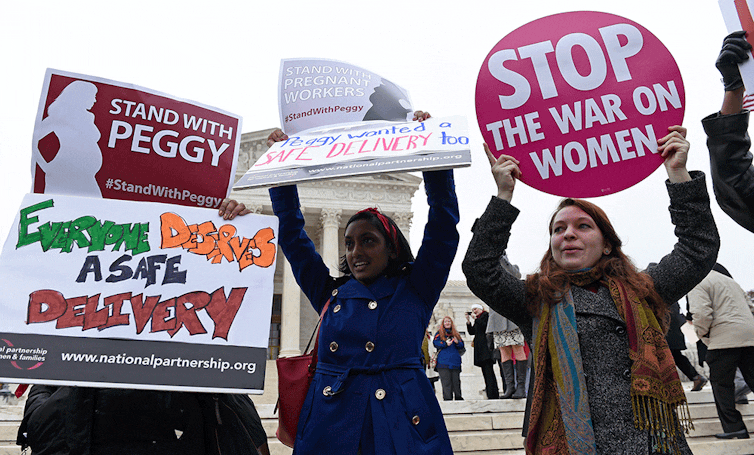Pregnant women shouldn't have to choose between a job and a healthy baby
In most states, employers aren't required to accommodate the unique needs of pregnant women except in limited circumstances.

Pregnant women in low-income work often face an unappealing choice: lose their job or perform duties that endanger their health and that of their baby.
Walmart, the biggest private employer in the U.S., is a case in point. In 2007, the retailer fired Heather Wiseman for carrying around a bottle of water – despite a doctor’s note saying it was necessary for her pregnancy. A decade later Walmart forced Whitney Tomlinson to take unpaid leave after she revealed her pregnancy-related lifting restrictions.
These aren’t isolated cases. A 2018 New York Times investigation found that some of the largest American companies – including Walmart, AT&T, Merck and Whole Foods – “systematically sideline pregnant women,” “pass them over for promotions and raises” and “fire them when they complain.”
In 2012, I wrote a law review article that explored the ways employers refuse to provide simple accommodations to low-income pregnant workers, such as letting them drink from a water bottle or having co-workers help with heavy lifting. Since then, 18 states have passed laws that require employers to provide pregnancy accommodations, bringing the total to almost two dozen.
But as The New York Times report shows, more needs to be done to ensure women don’t have to make a choice between the health of their babies and earning an income.
A right to accommodation
Recent research suggests that pregnancy discrimination is particularly problematic for low-income women.
While the difference in employment rates between pregnant and nonpregnant women who earn US$20,000 a year or more is relatively small, the gap is more than 11 percentage points among poorer women. And the data already exclude women who have voluntarily exited the workforce, meaning they focus on the more than 60 percent of pregnant women who depend on a paycheck to support their growing families.
Congress passed the Pregnancy Discrimination Act in 1978 to prevent such discrimination. Unfortunately, it hasn’t resolved the problem because, unlike its counterpart, the Americans with Disabilities Act, it does not provide an absolute right to workplace accommodations. Instead, it directs employers to treat pregnant workers the same as similar colleagues.
But since pregnant workers have special concerns – such as a need for easy access to water, lifting restrictions or maternity-fit uniforms – discrimination claims tend to fail because they cannot find a comparable nonpregnant coworker who needs the same accommodation.
States lead the charge
In recent years, states have been filling this gap by passing statutes that provide pregnant workers with an absolute right to workplace accommodations.
The number of states with such laws has almost doubled from just 12 in 2014 to 23 today. And Kentucky is on course to becoming the 24th after its Senate passed an accommodation bill in February.
In addition, in 2015, the Supreme Court, in Young v. UPS, clarified the kind of employer accommodation policy that would violate the Pregnancy Discrimination Act. Specifically, it ruled that an employer that provides pregnant workers less generous accommodations than nonpregnant workers violates the act if it imposes a significant burden without a “sufficiently strong” nondiscriminatory reason.
In other words, an employer can’t simply claim that accommodating a pregnant worker is more expensive or less convenient.

Limited impact
While this caused a spike in the number of claims filed with the Equal Employment Opportunity Commission, the Young decision’s vagueness limited its positive impact.
The number of pregnancy accommodation complaints rose dramatically from just 15 in 2013 to 676 in 2017.
But the Supreme Court didn’t explain what it meant by a “sufficiently strong” reason, allowing employers to continue to argue that accommodating other workers does not trigger an obligation to provide pregnancy accommodations.
In October, a federal district court accepted this argument, ruling that Young allowed an employer to reject a pregnant worker’s request for a lifting accommodation even though the employer had provided that same arrangement to other employees. The reason it gave was that the accommodated workers had been injured on the job.
And now employers are arguing that they shouldn’t have to provide pregnant workers with the same accommodations they offer employees under the Americans with Disabilities Act, which would make it even harder to file a successful claim.
Two solutions
So what’s to be done?
One option is passing a new federal law that requires all employers across the U.S. to provide reasonable accommodations to pregnant women. The Pregnant Workers Fairness Act, for example, would do just that. It is nearly identical to many of the recently enacted state statutes, except that it would exempt companies with fewer than 15 employees.
Although it’s been introduced in every Congress since 2012, it has yet to get a hearing. This could change in the current Congress, which has a record number of women.
There’s another option, however: Extend the American with Disabilities Act so that it covers the physical limitations that accompany a healthy pregnancy. Congress broadened the act in 2008 to cover pregnant workers with certain medical conditions like gestational diabetes and pregnancy-induced high blood pressure. Extending it further would require only a small change.
One major objection to this approach, of course, is that the word “disability” connotes a lack of work capacity, a stigma that may harm not only currently pregnant workers but women overall. But this assumption misunderstands the American with Disabilities Act, which differs significantly from earlier disability laws that viewed such people as defective.
Just as the act reshaped the workplace to accommodate disabled people who were previously excluded, it can do the same for pregnant women, recognizing them as legitimate wage earners. There’s no stigma in that.
Jeannette Cox does not work for, consult, own shares in or receive funding from any company or organization that would benefit from this article, and has disclosed no relevant affiliations beyond their academic appointment.
Read These Next
Absence of evidence is not evidence of absence – and that affects what scientific journals choose to
Researchers design studies that might disprove what’s called their null hypothesis – the opposite…
Pentagon investigation of Sen. Mark Kelly revives Cold War persecution of Americans with supposedly
President Donald Trump and his supporters cast their domestic opponents as disloyal, traitorous or worse,…
What makes a true Santa is inside – and comes with the red suit
Researchers who surveyed 849 professional Santas found that one-third of them didn’t adhere to the…





